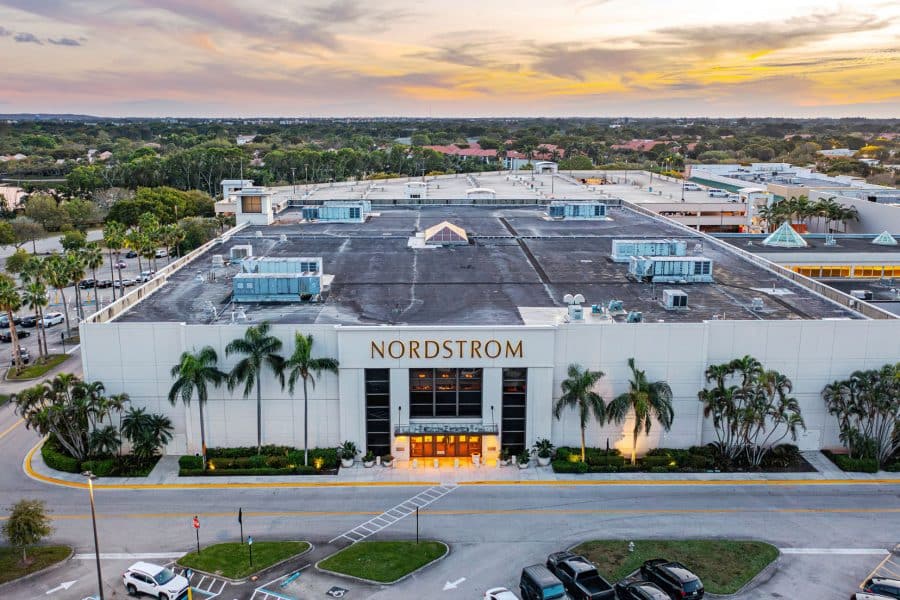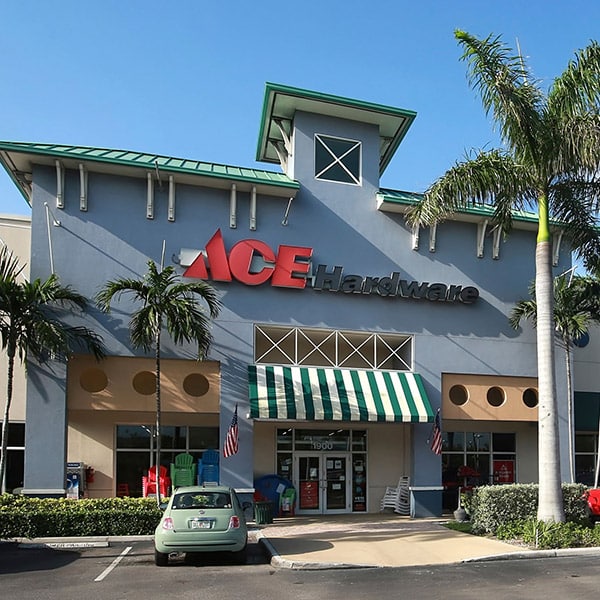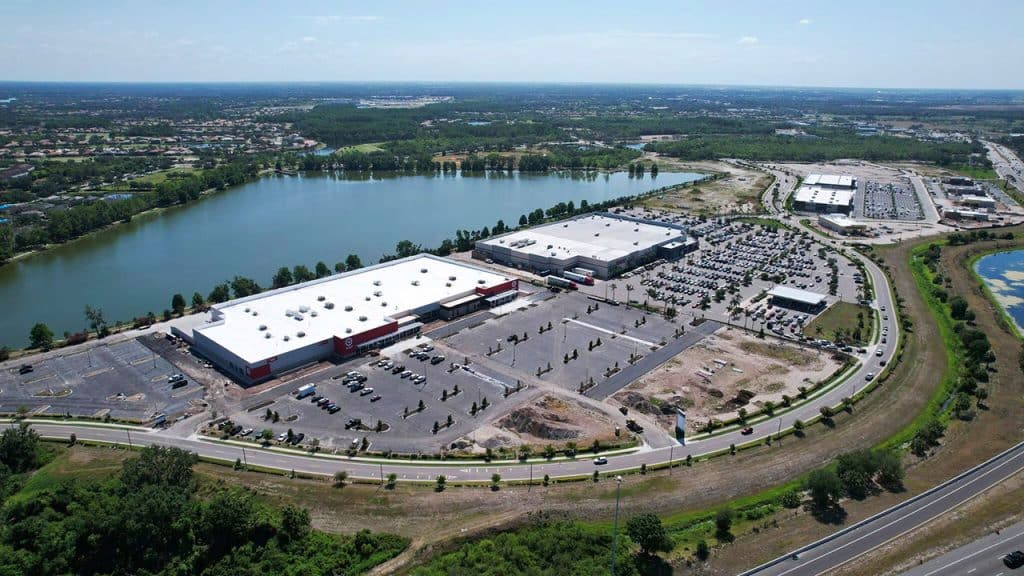
Retail resilience
Experts have declared traditional retail dead at least three times over the past 25 years. First came the dot-com craze and the rise of e-commerce, then recession brought by the Great Financial Crisis, and finally the global pandemic and lockdown of brick-and-mortar retailers. These three events, highlighted in the shaded boxes in Figure 1, were accompanied by sharp depreciation in both public and private retail markets. But the resilient U.S. consumer has fueled yet another rebound in the ever-cyclical sector. Recent trends seem particularly strong in Florida and across the Sunbelt, which has enjoyed strengthened retail demand, buoyed by a surge in population in recent years. What puzzles industry experts is that retail construction in the Sunshine State has failed to keep pace with strong consumer demand.
Figure 1 also reveals that retail appreciation was very weak for the few years prior to the 2020 pandemic. Despite some timing differences, public and private markets agree that the retail sector struggled from 2016 to 2024 following a period of very strong appreciation. Some aspects of retail property may never be the same. Mid-level malls may disappear, and community shopping centers may expand showroom space and mail-order returns. But other traditional retail property features remain and are poised for growth at a new equilibrium.
Source: NCREIF
Current conditions
According to CBRE Econometric Advisors’ U.S. Real Estate Market Outlook 2025, the national retail market has been tightening as demand absorbed available space. New supply has been developed at a rate below absorption, leading to falling vacancy. The CBRE report states, “Despite lower interest rates, the high cost of capital will make it challenging to finance new projects and expansions.” Analysts suggest that rents have not kept pace with construction costs, resulting in very little direct retail development. Rather, the majority of retail construction is part of mixed-use projects.
The pattern of growing demand and limited supply has led to low availability (vacancy) in the national retail sector. Cushman & Wakefield MarketBeats offers vacancy estimates across major markets. Figure 2 shows current U.S. retail vacancy at 5.4% which is low by historical standards. Vacancy in Florida is more dramatic, where major markets, with the exception of Jacksonville, exhibit significantly lower rates than the nation, with Miami being the tightest market at 2.7% vacant.
Source: Cushman & Wakefield MarketBeats, 4Q2024 or 1Q2025
There is reason to believe that the future for retail investment may be brighter than the recent past, particularly for Florida. UF’s Bureau of Economic and Business Research (BEBR) forecasts Florida’s total population to grow by almost 5 million people over the next 25 years, leading to an estimated 28 million residents in 2050. This represents a 20% increase in domestic demand. At such low vacancy levels, the state’s strong projected population growth suggests that approximately 140 million additional square feet of retail space may be needed to meet consumer demand. Given the challenge to finance new retail development, this implies a future of rent growth and expansion.
None of this is a surprise to Duane Stiller, founder of Woolbright Development, a Boca Raton-based retail center developer who has tracked Florida’s retail market for almost 40 years. Stiller continues to see great retail opportunities, especially within Florida’s six major markets – Southeast Florida, Naples-Fort Myers, Sarasota-Bradenton, Tampa, Orlando and Jacksonville. According to the Woolbright team, there is just one major retail development (defined as greater than 70,000 square feet of gross leasable area, or GLA) that will be delivered in one of these primary markets this year: The Marketplace at Heritage Harbour in Bradenton, Fla. Developments of this magnitude are few and far between in Florida, despite the overall evident need for supply. That is in part due to the average construction growth rate for standalone retail being almost 0% over the past four years, according to Woolbright research.

Retail supply growth has actually been negative in some submarkets. According to Scott MacLaren at Stiles Corp., developers found underutilized retail parking lots to be ideal redevelopment sites for multifamily, medical office, self-storage, industrial, or other in-demand products over the past ten years. There was a strong focus on supplying housing for those fleeing other markets, rather than providing necessary services, food and beverage, and entertainment. In many cases, even when developers tried to bring new retail space to a given market, they were priced out by more dense uses such as multifamily.

Firms like Woolbright have maintained a value-add acquisition investment strategy of “buy-fix-sell” until the ratio of rents to costs improves. Over the last decade, the company has acquired 56 retail centers, totaling 8.5 million square feet. Similarly, all 11 of Regency Centers’ current projects in Florida are redevelopments. Regency Centers is a large shopping center REIT based in Jacksonville. These deals reflect the positive investment sentiment about Florida in general at a time when new retail development has not yet recovered. “We’re big believers in Florida,” said Hap Stein, executive chairman of Regency Centers, during a recent Ring Speaker presentation at the University of Florida.
Subsectors
In Florida, as in the U.S., some retail formats are stronger than others. Total retail returns from the National Council of Real Estate Investment Fiduciaries (NCREIF) for Florida look similar to those of the U.S. over the last decade. These returns are compared in Figure 3A, which reveals that Florida’s retail returns are more volatile than the nation’s. Compounding this appreciation over the decade leads to slightly better than average performance in Florida.
Source: NCREIF, June 2025
Separating this performance into each retail subsector brings to light differences between the two markets. Florida power, neighborhood and community shopping centers outperformed the U.S. in cumulative appreciation during the past 10 years. The state underperformed in the mall and fashion sectors. The most notable bright spot for Florida has been the returns of community and neighborhood shopping centers. Florida community centers produced 7% appreciation to U.S. 5% depreciation, and neighborhood centers delivered 20% appreciation to U.S. 5% appreciation. Annual comparisons are shown in Figures 3B & 3C. Community centers are defined by the International Council of Shopping Centers as commonly being configured in a straight line as a strip, or as an L or U shape. These shopping centers offer general merchandise and convenience products, with a GLA ranging 125,000 to 400,000 square feet.
Source: NCREIF, June 2025
Source: NCREIF, June 2025
Relative value
A price index from Morgan Stanley Capital International’s Real Capital Analytics outlines another key difference between the Florida retail market and that of the U.S. This index gauges transaction pricing within the commercial retail space, allowing for clear analysis as to how Florida retail assets are viewed relative to the rest of the country. Beginning in 2018, the two indexes began to diverge, with Florida’s Retail Commercial Property Price Index (CPPI) rising towards 100, and the U.S. index remaining flat (Figure 4). From there, the respective trends continue, with Florida sitting at approximately 136 at year-end 2024, and the nation at 106. This continues to strengthen the positive sentiment around retail demand in Florida compared to the U.S. and to retail’s recent past.
Source: MSCI Real Capital Analytics, April 2025
Caution
Market data emphasizes the strength of Florida’s current retail sector. Despite the positive outlook, conditions are fragile and uncertainties are emerging. Specifically, tariffs may present new challenges to the retail sector. According to a recent CoStar article headlined “New wave of tariffs expected to rock U.S. retail,” retailers are taking it day-by-day. John David Rainey, chief financial officer at Walmart, said, “We’ve lived in a tariff environment for the last seven or eight years, and we’ll do what we know how to do. We’ll work with suppliers.” Ultimately, the impact depends on how these challenges unfold, leaving us in a period of watchful waiting.
Outlook
With strong population growth and limited new development, there is a growing tension in the Florida retail sector. A tension that may lead to rising rents that ultimately encourage new development. Tariffs may test the retail market’s resilience once again, but one thing remains clear: the retail consumer continues to demonstrate strength and adaptability in all kinds of weather. Florida may have just the weather to seed sustained retail growth.
Emma MacLaren is a graduate of the University of Florida Nathan S. Collier Master of Science in Real Estate program.
Related stories
For the media
Looking for an expert or have an inquiry?
Submit your news
Contact us
Follow us on social
@ufwarrington | #BusinessGators


